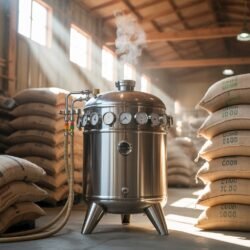The future of anaerobic fermentation in coffee is shaped by a convergence of emerging technologies, creative processing innovations, and shifting consumer preferences. As the specialty coffee market continues to evolve, producers, roasters, and consumers alike are eager to explore new possibilities and push the boundaries of flavor and quality.
Emerging Technologies
– Precision Fermentation Control:
Advances in fermentation technology are enabling producers to monitor and control key variables—such as temperature, pH, and gas composition—with unprecedented precision. Smart sensors and automated systems allow for real-time adjustments, ensuring consistent results and minimizing the risk of spoilage or off-flavors.
– Microbial Inoculation:
Producers are experimenting with introducing specific strains of yeast and bacteria to guide fermentation. By selecting microorganisms known to produce desirable flavors, they can tailor the fermentation process to achieve targeted taste profiles.
– Closed-Loop Systems:
Closed-loop processing systems, which recycle water and organic byproducts, are gaining traction. These systems reduce waste and environmental impact while maintaining the quality and consistency of the final product.
Experimental Processing Methods
– Carbonic Maceration:
Inspired by winemaking, carbonic maceration involves placing whole, undamaged coffee cherries in a sealed vessel and flushing it with carbon dioxide. This creates a CO₂-rich, oxygen-free environment that encourages intracellular fermentation, resulting in coffees with intense, winey flavors and pronounced red fruit notes. Producers can manipulate temperature and fermentation time to further customize the flavor profile.
– Extended and Multi-Stage Fermentation:
Some producers are pushing fermentation times to new extremes, with processes lasting weeks or even months. Multi-stage fermentation, where coffee undergoes different types of fermentation in sequence (e.g., aerobic followed by anaerobic), is also being explored to create even more complex flavor profiles.
– Koji and Other Microbial Cultures:
Borrowing from Japanese fermentation traditions, some producers are experimenting with koji (a type of mold) to break down starches and proteins, unlocking new layers of umami and sweetness in the coffee.
Evolving Consumer Preferences
– Demand for Unique and Complex Flavors:
Coffee consumers are increasingly seeking out unique, memorable flavor experiences. Anaerobic and carbonic maceration coffees, with their wine-like acidity, fruity esters, and complex aromatics, are well-positioned to meet this demand.
– Transparency and Traceability:
Consumers want to know more about how their coffee is produced. Producers who can clearly communicate their fermentation techniques, sourcing practices, and sustainability efforts are likely to gain a competitive edge.
– Sustainability and Ethical Production:
As environmental concerns grow, consumers are prioritizing sustainably produced coffee. Anaerobic fermentation—especially when paired with closed-loop systems and renewable energy—can be marketed as a more sustainable alternative to traditional processing methods.
Looking Ahead
The future of anaerobic fermentation is bright, with ongoing innovation and experimentation driving the industry forward. Producers who embrace new technologies, explore creative processing methods, and respond to evolving consumer preferences will be at the forefront of the specialty coffee movement. As techniques like carbonic maceration become more refined and accessible, we can expect to see even more exciting and diverse coffee offerings on the market.
In summary, anaerobic fermentation is not just a passing trend—it’s a dynamic field that continues to evolve, offering new opportunities for flavor innovation, sustainability, and market differentiation. The next decade will likely see even more groundbreaking developments as producers and consumers alike explore the full potential of coffee fermentation.


